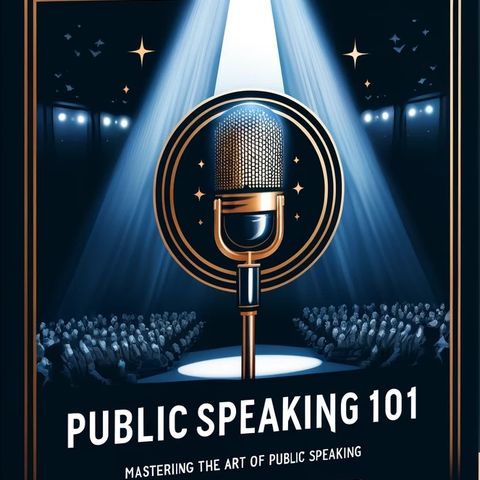Public Speaking 101: Mastering the Art of Engaging and Influential Communication

Download and listen anywhere
Download your favorite episodes and enjoy them, wherever you are! Sign up or log in now to access offline listening.
Public Speaking 101: Mastering the Art of Engaging and Influential Communication
This is an automatically generated transcript. Please note that complete accuracy is not guaranteed.
Description
Public speaking is a crucial skill in both personal and professional life. Whether you're presenting at a conference, delivering a wedding toast, or pitching a business idea, the ability to...
show moreEffective public speaking begins with thorough preparation. Start by researching your audience to understand their demographics, interests, and expectations. This knowledge will help you tailor your content and style to resonate with your listeners. Next, define the main objective of your speech and develop a clear, concise, and compelling central message.
Organize your content by creating a structured outline that includes an introduction, body, and conclusion. Use transitional phrases to ensure a logical flow of ideas. Craft an engaging introduction that captures attention, establishes credibility, and previews the main points of your speech. Develop a strong conclusion that summarizes key takeaways, provides a call-to-action, and leaves a lasting impression.
To create compelling and memorable messages, incorporate storytelling techniques such as anecdotes, analogies, and real-life examples. These elements help create vivid imagery and emotional connections with your audience. Employ rhetorical devices like repetition, alliteration, and rhetorical questions to emphasize key points and maintain engagement.
Support your ideas with evidence, including statistics, expert opinions, and case studies. Ensure the credibility and relevance of your sources to strengthen your arguments. When presenting complex concepts, use plain language and avoid jargon. Provide clear explanations and visual aids to facilitate understanding.
Anticipate and address potential counterarguments or alternative perspectives. Acknowledging these points demonstrates your understanding of the topic and allows you to provide convincing rebuttals, further strengthening your position.
Effective delivery is essential for engaging and connecting with your audience. Master nonverbal communication by maintaining eye contact, using open and confident body language, and employing facial expressions to convey emotions and emphasize key points. Develop vocal variety by varying your tone, pitch, and volume to add interest and emphasis. Use pauses strategically to allow for reflection and impact.
Practice active listening by paying attention to audience reactions and adapting your delivery accordingly. Encourage participation, when appropriate, to foster engagement and create a dynamic atmosphere. During the Q&A session, anticipate potential questions and prepare concise, informative responses. Handle challenging or unexpected questions with grace and diplomacy.
Visual aids can greatly enhance your message and engage your audience. Choose visuals that clarify, reinforce, or complement your content. Ensure that they are high-quality, legible, and visually appealing. Integrate visual aids seamlessly into your presentation by practicing synchronization with your speech. Avoid relying too heavily on visuals or reading directly from slides.
Maintain a balance between content and visuals, using them to enhance, not overwhelm, your message. Keep text minimal and focus on key ideas or data points to maximize the impact of your visual aids.
Public speaking anxiety is a common challenge, but it can be managed and overcome. The key to building confidence is practice. Rehearse your speech multiple times to build familiarity and seek feedback from trusted friends, colleagues, or a public speaking coach. Embrace nervous energy by reframing it as excitement and channeling it into your delivery. Use deep breathing and relaxation techniques to manage anxiety.
Visualize success by imagining yourself delivering your speech with clarity, confidence, and impact. Focus on positive outcomes and the value you provide to your audience. Develop a pre-speech routine that includes calming rituals, such as meditation or power poses, to center yourself. Arrive early to familiarize yourself with the venue and test any technology.
Learn from each experience by reflecting on your successes and areas for improvement. Seek feedback from audience members and use it to refine your skills continuously.
Authenticity and ethics are crucial for building trust and credibility as a public speaker. Develop a personal speaking style that reflects your values and personality. Avoid imitating others and embrace your unique voice and perspective. Prioritize honesty and transparency by presenting information accurately and acknowledging limitations in your knowledge. Disclose any potential biases or conflicts of interest.
Respect your audience by being mindful of diversity and avoiding language or humor that may offend or exclude. Show genuine interest in your listeners' needs and perspectives. Maintain ethical standards by giving proper credit to sources, avoiding plagiarism, and using your platform responsibly to promote the greater good.
Public speaking is a skill that can be developed and refined through practice, self-reflection, and continuous learning. By mastering the art of preparation, content creation, delivery, and managing anxiety, you can become a confident and influential communicator.
Remember, the key to successful public speaking lies in authenticity, transparency, and a genuine desire to inform, inspire, and engage your audience. By staying true to yourself, respecting your listeners, and maintaining ethical standards, you can build trust, credibility, and lasting impact.
Information
| Author | QP-4 |
| Organization | William Corbin |
| Website | - |
| Tags |
Copyright 2024 - Spreaker Inc. an iHeartMedia Company
